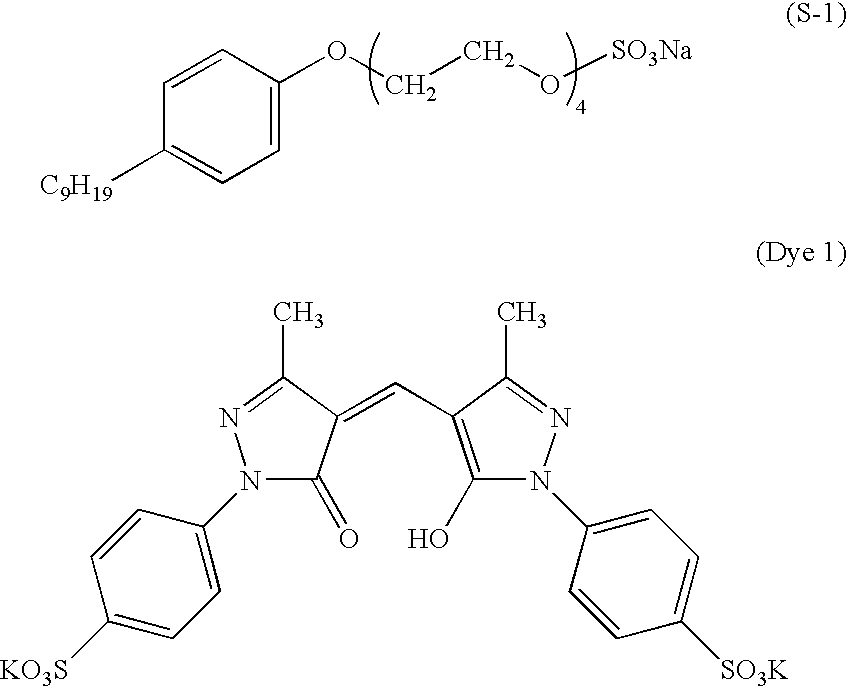Process for preparing conductive material
a technology of conductive materials and conductive layers, applied in the direction of photosensitive materials, conductive layers on insulating supports, instruments, etc., can solve the problems of high cost and poor productivity, inability to meet the conventional methods, and the resistance of the pattern becoming too high
- Summary
- Abstract
- Description
- Claims
- Application Information
AI Technical Summary
Benefits of technology
Problems solved by technology
Method used
Image
Examples
example 1
[0211]Examples of the first embodiment of the present invention are shown below. To prepare a precursor for the conductive material, a polyethylene terephthalate film with a thickness of 100 μm having a layer containing poly(vinylidene chloride) was used as a transparent support. Before coating a physical development nuclei layer, a base layer with a gelatin dry weight of 50 mg / m2 was coated on the film and dried. Next, a physical development nuclei layer coating solution containing palladium sulfide was prepared in the following manner.
[0212]
Solution APalladium chloride5gHydrochloric acid40mlDistilled water1000mlSolution BSodium sulfide8.6gDistilled water1000ml
Solution A and Solution B were mixed under stirring, and after 30 minutes, the mixture was passed through a column filled with an ion exchange resin to obtain palladium sulfide sol.
[0213]
The above-mentioned palladium sulfide sol50 ml2% by weight glutaraldehyde solution20 mlSurfactant (S-1) 1 g
[0214]water was added to make up ...
example 2
[0233]By using the post-treatment solution 1-9 of Example 1, the same test was carried out in the same manner as in Example 1 except for changing the treatment temperature and treatment time. As a result, the results shown in Table 3 were obtained.
[0234]
TABLE 3SurfaceSurfaceresistanceConductiveTreatmentTreatmentresistancevalue (%)materialtemperaturetimevalueHalf-valueafterNo.(° C.)(second)(Ω / □)widthheatingRemarksB-13090500.3380PresentinventionB-24090300.3290PresentinventionB-35090300.31100PresentinventionB-46010300.3290PresentinventionB-56030200.31100PresentinventionB-66060150.3100PresentinventionB-76090150.3100PresentinventionA-15NoneNone1500.4550Comparative
[0235]From Table 3, in the case of 60° C., it can be well understood the surprising effects of the present invention that the resistance value drops⅕ of the original value with the post-treatment only for 10 seconds.
example 3
[0236]In the same manner as in Example 1, a back-coating layer was coated onto a polyethylene terephthalate film.
[0237]Subsequently, on an opposite surface of the support on which a back-coating layer has been provided, a silver halide emulsion layer 2 was coated. The silver halide emulsion was prepared by a double jet mixing method which is general in a silver halide emulsion for photography. This silver halide emulsion was so prepared that 40 mol % of silver chloride and 60 mol % of silver bromide, and an average particle size became 0.15 μm. To the thus obtained silver halide emulsion was applied a gold-sulfur sensitization using sodium thiosulfate and chloroauric acid according to the conventional manner. The thus obtained silver halide emulsion contains 1 g of gelatin per 3 g of silver.
2>
[0238]
Gelatin 1 gSilver halide emulsioncorresponding to3.0 g of silver1-Phenyl-5-mercaptotetrazole3.0 mgSurfactant (S-1) 20 mgGlyoxal (40% by weight aqueous solution) 50 mg
[0239]The thus obtai...
PUM
| Property | Measurement | Unit |
|---|---|---|
| temperature | aaaaa | aaaaa |
| temperature | aaaaa | aaaaa |
| temperature | aaaaa | aaaaa |
Abstract
Description
Claims
Application Information
 Login to View More
Login to View More - R&D
- Intellectual Property
- Life Sciences
- Materials
- Tech Scout
- Unparalleled Data Quality
- Higher Quality Content
- 60% Fewer Hallucinations
Browse by: Latest US Patents, China's latest patents, Technical Efficacy Thesaurus, Application Domain, Technology Topic, Popular Technical Reports.
© 2025 PatSnap. All rights reserved.Legal|Privacy policy|Modern Slavery Act Transparency Statement|Sitemap|About US| Contact US: help@patsnap.com

